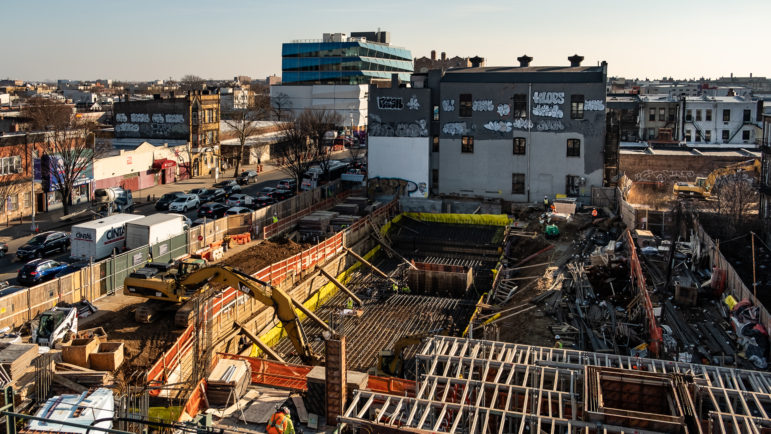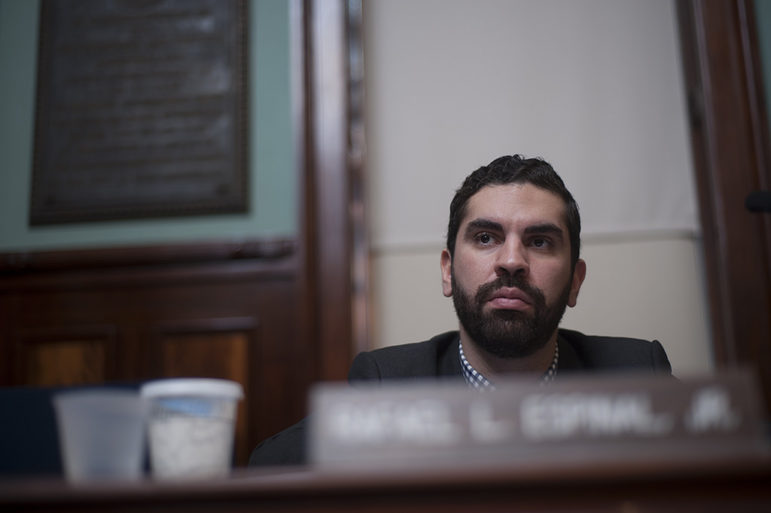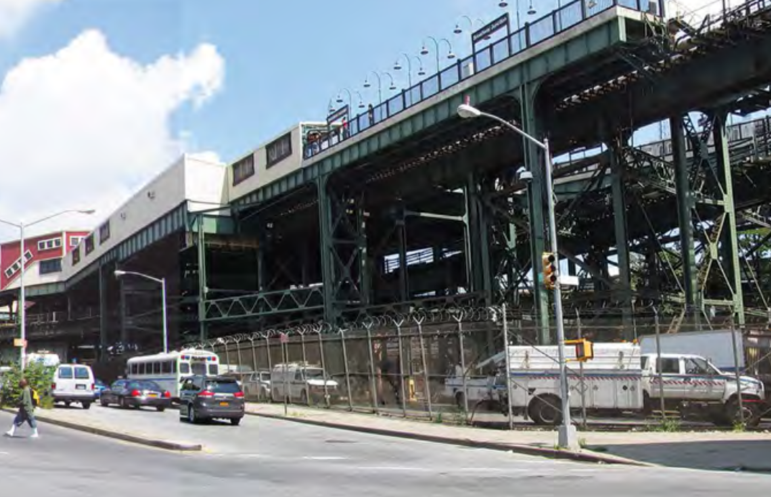
Adi Talwar
50 Pennsylvania Avenue, one of several affordable housing development sites in East New York. While housing creation has lagged, there are multiple projects in the pipeline. But there are concerns about how budget cuts might imperil future deals.Four years after Brooklyn’s East New York neighborhood was rezoned, residents, community groups and the borough president’s office are voicing their concerns over whether benefits promised to the neighborhood are being delivered–and how the COVID-19 budget crunch might affect the city’s ability to make good on the rest of the to-do list.
“The city has fallen short on a lot of the promises that were to come through for the East New York rezone,” says Alexa Sloan, organizing member of the Coalition for Community Advancement: Progress for Cypress Hills and East New York. “The city unlocked the density and height requirements and that allowed for a lot of interest in real-estate speculation and development for East New York.”
Concerns about housing availability and speculation were prominent when the rezoning–Mayor de Blasio’s first–was under consideration. They stemmed from the fact that East New York has seen decades of disinvestment.
Now the area is reeling from the coronavirus epidemic. According to the city’s health department, the East New York neighborhood has been one of the hardest hit by the Coronavirus in Brooklyn. In East New York rezoning zip codes 11207 and 11208, there have been a combined total of 4,246 COVID-19 cases and 408 deaths, according to the city’s data map.
“When it comes to affordable housing, what was promised and the units being built, I would say that is still on track,” says Rafael Espinal, who as Councilmember negotiated the benefits that came with the rezoning and, by Council custom, had to assent for the rezoning to pass. He now heads the Freelancers’ Union. “Has it moved slower than we hoped? Of course. But I think at the end of the day, we’re going to see everything that was promised.”
The first of … a few
The East New York rezoning spanned 190 blocks in the East New York, Cypress Hills and Ocean Hill neighborhoods. It was supposed to bring affordable housing, economic development, enhanced open space, new schools and other investments after community members and elected officials negotiated with the city for a $250 million capital commitment.
When it passed the Council, it was billed as the first of many: The mayor was planning to rezone as many as 15 neighborhoods as part of his housing plan, which sought to use greater density as a tool to create more affordable units. With just under two years left in his tenure, de Blasio has rezoned only six areas (East New York, Downtown Far Rockaway, East Harlem, Bay Street, Jerome Avenue and Inwood), and, after efforts to rezone Southern Boulevard and Bushwick bogged down in 2019, it appears Gowanus will be the final de Blasio rezoning–although that process has been halted indefinitely by the COVID-19 crisis.
In the East New York rezoning points of agreement, a document which lists the capital investments negotiated between the administration and Espinal, the city promised 1,300 affordable housing units — under the Mandatory Inclusionary Housing rule — in the first two years of the rezoning. Overall, the rezoning action could bring in 3,538 dwelling units over a 15 year period (by 2030), according to the environmental impact statement.
It also promised to publish a study for a pilot basement legalization program, build a 1,000-seat new school, acquire or renovate a new childcare center, and complete projects to improve transportation infrastructure, local parks, community centers and the environment over a 15-year period. Another promise included the revitalization of the East New York Industrial Business Zone with 20 commitments that would have brought in over $16 million in infrastructure improvements and make better use of underutilized properties. Those commitments would provide space for 250 additional companies and 4,000 new jobs.
Michelle Neugebauer, the Cypress Hills Local Development Corporation executive director, says there has been progress made in the rezoning. The 1,000-seat new school, local park improvements, a new NYPD community center and programs that provide access to fresh food are all underway or have been completed.
“The city has fulfilled multiple infrastructure commitments over the past year, including several important projects in East New York. From the opening of the NYPD Community Center and renewal of City Line Park to numerous in-progress park and streetscape upgrades, this neighborhood plan is making headway. We look forward to furthering our work in East New York,” the Department of City Planning said in an email to City Limits.
Housing creation and job production lag
But the slow growth of jobs and slow development of new affordable housing are a concern.
According to HPD, since the rezoning was approved there have been 503 new affordable housing units built or financed, including 187 under Mandatory Inclusionary Housing, the mechanism that compels market-rate developers to devote a share of apartments to targeted income groups. That’s shy of the 1,300 that was promised..
“We’re four years in and we did a little retrospective last year [with] the coalition where we got together and talked about serious concerns about the affordability and that the production wasn’t where it needed to be,” says Neugebauer. “One of the other changes was the city would invest a lot of capital money in the IBZ, to improve certain buildings, the infrastructure, the broadband access, and that would create 3,900 jobs. And so we’re four years in and nobody has reported on one job being created.”

William Alatriste for the City Council.
Espinal’s departure from the Council earlier this year and the cancellation of a special election to replace him mean East New York will go 10 or more months without representation on the Council.City Limits requested information about job creation from the administration but there was no data available: the Economic Development Corporation referred us to the Department of Small Business Services, who said the only data they had available was on the local Workforce 1 Center. SBS says the East New York Workforce 1 Center has connected 613 individuals to employment between January 2017 and February 2020, but it was unclear where those jobs were located.
The 1,300 housing units promised within the first two years of the rezoning relied largely on a single site with 900 units. The site was formerly known as the Chloe Foods facility at 3301 Atlantic Avenue, and it was severely damaged during a fire in 2012. According to former Councilmember Espinal, there were legal entanglements that delayed its construction. But the site will be constructed and it is slated for a mixed-use development which will include 1,165 fully-affordable units across three 14-story buildings.
HPD says there are dozens more affordable housing development plans underway. Just blocks away from Chloe Foods, Chestnut Commons is slated for a 14-story building with 274 permanently affordable housing units at 3269 Atlantic Avenue. Last August, the Empire State Diary site, a historic landmark, was approved by the city’s Landmarks Preservation Commission for another 14-story building with 335 affordable housing units at 2840 Atlantic Avenue.
The agency also says that besides new construction, there are efforts underway to preserve existing housing, by protecting unregulated apartments and assisting landlords who need financing to keep buildings safe and affordable. But one possible mechanism for doing that, the basement legalization pilot, suffered a major blow when the mayor proposed a debilitating budget cut for next fiscal year.
Other cuts could also hurt East New York. In the mayor’s latest budget proposal, HPD’s capital budget was decreased from $1.48 billion to $902 million in the current fiscal year (2020) and from $1.19 billion to $741 million in the following fiscal year.
Coalition for Community Advancement members are apprehensive since hearing about the budget cuts to de Blasio affordable housing plan. “The housing that’s actually truly affordable is the subsidized housing that comes from the city,” says Sloan. “There is a lot of market rate housing that can come in and that has come in where you need to make $60,000 in order to qualify for these units. And that’s not truly affordable to the people that live in the neighborhoods. And so the real affordable housing that would’ve come in would have been through these subsidized units from the city.”
Brooklyn Borough President Eric Adams’ office says it is also concerned about the cuts, although it is less concerned about the pace of housing construction so far. “[The city] understood this was going to take time for market absorption,” said one borough official.
The BP’s office says it has been concerned about the promised jobs–not just the number, but who gets them, what they pay and where they are located. And in keeping with Adams’ broader focus on health, the BP has pushed for access to healthier and fresh foods in the East New York community.

NYC DCP
One view of Broadway Junction. It could be the site for the next round of investment in the area.Hope for another redevelopment scheme?
Meanwhile, concerns about real-estate speculation persist. Another coalition member, Paul Muhammad of Mosque 7C, says homeowners are facing aggressive speculative investors and the trend has exacerbated after the rezoning. Mohammad says speculative investors have become so aggressive that the coalition has started a campaign to get legislation to mitigate issues such as deed theft from senior homeowners, cash buy-outs of properties and house flipping. “My family gets phone calls every single day and some have shown up at our doors,” he says. “Real estate is location, location, location. We are located in areas with the least resistance. The fact is we are poor people on valuable land.”
Bill Wilkins, the director of economic development for Local Development Corporation of East New York (LDCENY), says East New York deserves a focused city effort to bring jobs and educational opportunity to the area.
“The housing rezoning brought mandatory affordability, which was a solid first step, but a drop in the bucket for what could happen here,” he says. “Rather than give a few hundred families the chance to win the lottery for an apartment, why not empower hundreds of thousands of residents over generations to secure a job and economic security in the area–and ensure dependence on a lottery is a thing of the past?”
Wilkins says there are some major opportunities the city could seize to further the rezoning such as bringing business, academic and work space around the Broadway Junction transit hub. Last year in August, NYCEDC, Borough President Eric Adams and Espinal introduced Broadway Junction: A Vision for the Future plan which lays out strategies to turn the transit hub surrounded by auto repair shops, vacant lots, some restaurant chains with drive-thrus and the MTA bus depot into accessible transit hub, with new retail, employment and training opportunities.
“Broadway Junction is the biggest economic development opportunity in NYC, and it should be the centerpiece of an equitable and inclusive recovery plan for NYC post-Covid. There are five subway lines and a regional rail system that come together here. Anywhere else in the city where there is this abundance of transit infrastructure the zoning code supports a robust central business district. Think Penn Station, Grand Central, Jamaica, Queens, Downtown Brooklyn,” says Wikins.
Another new concern for residents and community groups is their lack of representation on the City Council since Espinal resigned in January. A special election was scheduled for April 28, but was cancelled because of the public-health emergency, so the seat will not be filled until the general election in November.
Espinal says he understands the community’s concerns about losing capital investments during budget cuts. “I think that this recent slash of funding to the basement program has really caused a lot of anxiety because if these promises were committed to and now you’re going back on some of your word, then what else should we be anticipating and be in store for moving forward?,” he said.
“East New York is a community that, while it has seen a historic amount of investment in the past six years, it will always continue to need to be a focus of the city’s, because we’ve dealt with so much inequity and so many issues for so long,” Espinal adds. “That is something that has continued to plague the community and I believe will not go away with one rezoning. So, I think it’s important that the city takes it very seriously when they look at what custody to take moving forward and ensure that they don’t continue to make cuts in neighborhoods like East New York that cannot afford to lose any funding.”










4 thoughts on “Worries About the Pace of Progress Four Years After East New York’s Rezoning”
deBlasio can forget about his ‘affordable housing’ program which is nothing more than a disastrous NYCHA 2.0. NYC is slowly going broke.
NYC’s new fiscal crisis:
http://u.pc.cd/9gg7
This is so important- to keep the momentum going forward in a community that has been disinvested for generations. It is a challenge for all to be included in such a impact- Either such plan works as envisioned, resulting in a generational reversal of missed economic/community renewal – or a new set of economic standards that will exclude them.- Keep going community voices!!
The MIH and rezoning in East N.Y. was designed that market rate housing should never be feasible, So that only 100% affordable housing should be built, and the commercial was designed so that only shelters should come there. The plan was and still is to keep it the shithole of the city, so that nobody should build a building or a business with private money. This is lobbied by Coalition of so called Community Advancement and to enrich the pockets of the Cypress Hills Local Development Corporation. As long as this community will remain asleep they will be run over by these horrible people.
Quoting from Espinal who utterly abandoned the community and cost the city millions for election, laughable he is taken seriously by anyone at all.